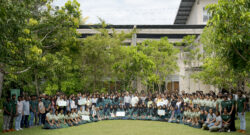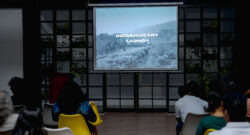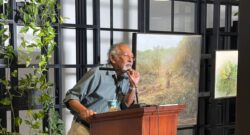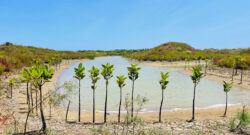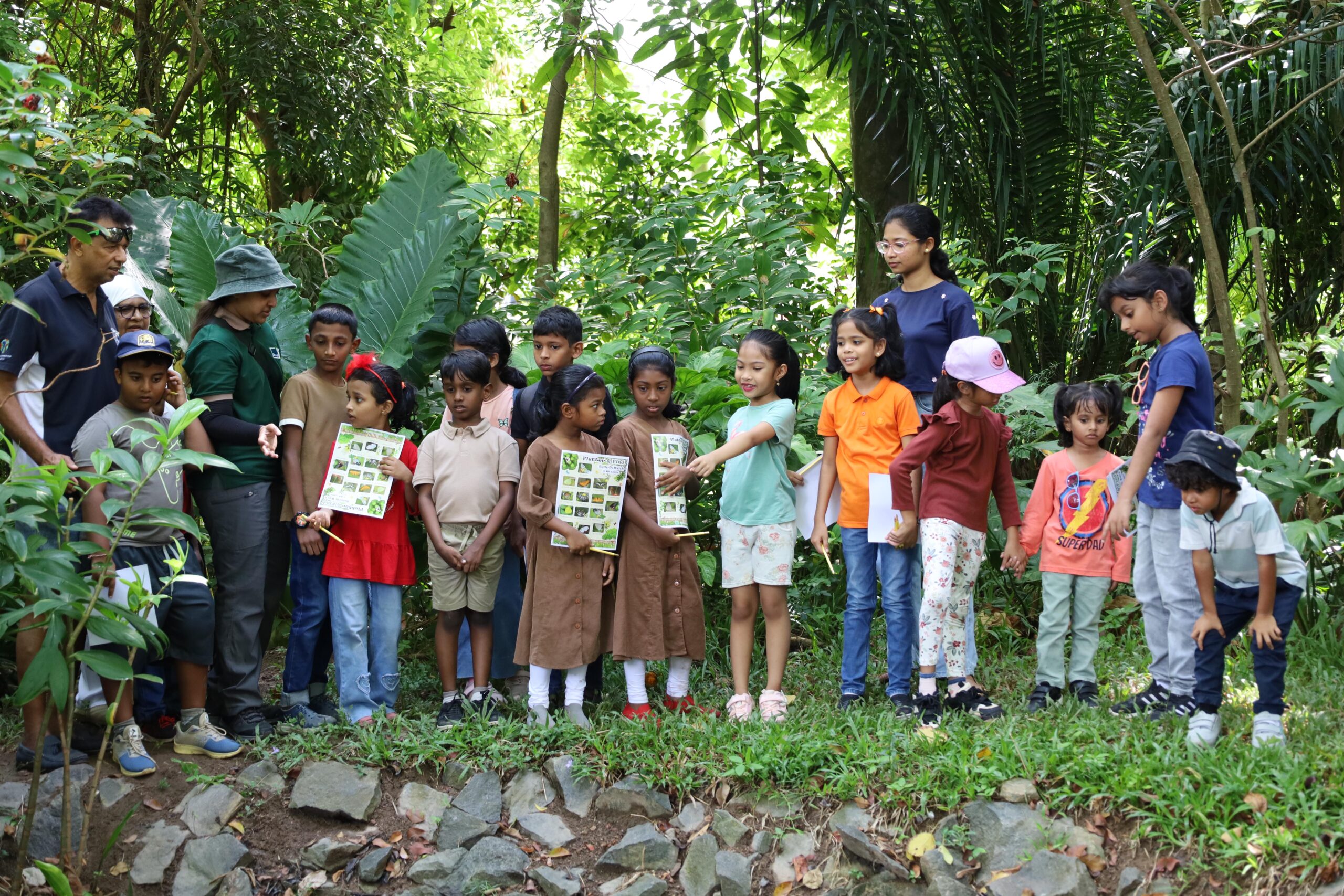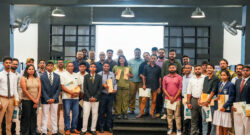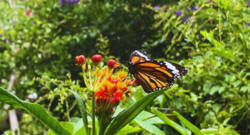Author: Nathasha Silva
Dilmah launches Grey2Green: An Urban Greening Project
Colombo is heating up! Over the past 20 years, rising concrete and shrinking greenery have pushed temperatures in the city’s built-up areas up by nearly 4°C. With this growing heat challenge, the message is clear: our city needs more green. That’s where Grey2Green steps in. Dilmah Conservation, together with the United Nations Global Compact Sri Lanka, launched Grey2Green; a fresh, citizen-led movement that invites everyone from university students to office teams, neighbourhood groups, and institutions to turn underused “grey” corners of the city into living, breathing green spaces. It’s more than just a tree-planting campaign. It’s a grassroots greening movement powered by people. Grey2Green encourages the public to transform rooftops, abandoned land, industrial plots, and neglected urban patches into pockets of biodiversity, focusing on, Urban forestry, Plant ecology, Landscape design, Ecosystem management. All to ensure that every green space created isn’t just beautiful — it’s ecologically meaningful and sustainable. Inspired by the One Earth Urban Arboretum One of the strongest inspirations behind this movement is the One Earth Urban Arboretum at our Moratuwa Centre — once an industrial waste site, now home to over 300 trees and shrubs. The transformation stands as a powerful reminder that even the most degraded spaces can be revived with science, care, and community effort. Grey2Green aims to replicate this model across Colombo and its suburbs, one restored space at a time. Event Highlights To spark conversation, the event began with an interactive Mentimeter quiz, inviting the audience to share their perceptions of urban greening. The responses helped set the tone, making it clear that people are ready, eager, and passionate about reimagining their city. Messages from the Experts The speakers shared insights that grounded the movement in both science and heart. Dr. Jagath Gunawardana, environmental lawyer, reminded us that green spaces are refuges for both wildlife and people. “If we stop seeing green, we will slowly lose our balance. Nature is not a luxury. It is a necessity.” Dr. Himesh Jayasinghe, plant taxonomist, highlighted the need for the right plants, the right planning, and strong community involvement. “Everyone wants green spaces, but we must also protect them. Leave only footprints.” Dr. Ajith Gunawardena from the Central Environmental Authority emphasized that urban greening is already a national priority, and young people and volunteers will play a crucial role in monitoring and stewardship. Treshan Galappathy of UNGC Sri Lanka connected Grey2Green to SDG 11 (Sustainable Cities) and SDG 13 (Climate Action) — reminding us that urban greening is a local action with global impact. Join the Movement Grey2Green is an invitation to co-create a Colombo where trees cool our streets, birds return to our skies, and communities thrive in healthier, happier spaces. Whether you’re a student, a neighbourhood group, an office, or simply someone who loves this city, you can be part of the change. Contact Dilmah Conservation to get involved:📞 011 4 822 490 / 216
Connecting Rainforests, Communities and Livelihoods
The newly launched documentary – Connecting Rainforests, Communities and livelihoods , shines a light on the remarkable journey of the Endane Biodiversity Corridor – a once-abandoned tea garden that has been transformed into a thriving 3 km-long biodiversity corridor, reconnecting two fragmented forests- Iharankanda and Walankanda. Started in 2018, the project focuses on restoring rare and threatened tree species, and has already led to the discovery of a new Memecylon plant species within the regenerated landscape. Beyond conservation, the initiative has brought meaningful change to the surrounding village and estate community, offering a model of forest restoration that the world can learn from. Created in collaboration with the Franklinia Foundation, Dilmah Tea, Kahawatte Plantations, and Rajarata University, the documentary captures this inspiring blend of nature, science, and community in action. It’s not just about planting trees. It’s about reconnecting ecosystems and empowering the people who live within them. A Story Told Through Real Voices The documentary captures the heart of this journey — from scientists mapping ecological needs, to local families caring for their surroundings, to the quiet beauty of an environment slowly returning to life. The documentary premiered at Genesis by Dilmah in Maligawatte, under the theme “Connecting Rainforest Communities and Livelihoods.” The evening brought together conservationists, academics, policymakers, private-sector leaders, and nature enthusiasts for an honest, warm conversation about the future of Sri Lanka’s forests — and the people who depend on them. Key speakers reminded us: “When forests connect, life thrives. When people connect with nature, sustainability begins.” Professor Ranasinghe highlighted the importance of biodiversity corridors as natural links that reconnect fragmented rainforests. These corridors help restore ecological balance, allow wildlife to move freely, and support the wellbeing of nearby communities. “It’s not just about planting trees. It’s about reconnecting lives; people, animals, and ecosystems,” she said, stressing that restoration must create real, lasting benefits for the local communities who protect these landscapes. She also commended ongoing community-led efforts, where degraded lands are being brought back to life and local residents are trained and empowered to steward their environment. “We are long on thought, short on time, and short on impact,” Dr. Dilhan C. Fernando reminded us, a powerful call to stop talking about change and start making it happen. He spoke about how deeply Sri Lanka’s natural beauty is woven into who we are and what we create. Without our forests, mountains, and people, even the things we cherish most from the charm of the Nine Arches Bridge to the flavour of Ceylon Tea, would lose their magic. He reminded us that real value isn’t just financial; it’s the life, culture, and nature that hold our world together. Nature is not optional, it’s essential And the documentary became the perfect closing note, showing what collaboration can achieve when science, community, and purpose come together. Looking Ahead The Endane Biodiversity Corridor is still growing, and so is the community around it. This documentary marks just one chapter in a much bigger story – a story of resilience, restoration, and hope.
Art for Conservation
Photography may often steal the spotlight in conservation storytelling, but art holds a quiet power of its own. This idea came to life at Art for Conservation: A Journey Through the Wild, an inspiring evening hosted at the Genesis – Dilmah Centre for a Sustainable Future. The session featured veteran wildlife artist Gamini Ratnavira, whose work spans over five decades and 55 countries. Through a captivating presentation and an engaging discussion, he shared how his brushstrokes have turned into a lifelong mission: using art to protect the natural world. Mr. Gamini’s paintings document more than beauty. It’s a way of reminding us of what we stand to lose, by capturing the stories of rare and endangered species – their fragility, their resilience, and the ecosystems they call home. Every piece becomes a window into the wild and a gentle invitation to care. Art, he believes, can be a bridge between awareness and emotion. When people see a painting, they don’t just observe an animal — they connect with it. They sense its delicate place in the ecosystem. They feel the urgency of protecting habitats that are disappearing far too quickly. The event drew a keen and thoughtful audience, all brought together by a shared belief: creativity becomes powerful when it serves a purpose. And in the world of conservation, art has the potential to transform understanding into empathy, and empathy into action. In the end, the evening was more than an appreciation of art; it was a reminder that conservation needs many voices. Whether through a lens or a paintbrush, every creative effort helps tell the story of our natural world — and why it is worth saving.
Dilmah Takes the Lead in Water & Ocean Stewardship in Sri Lanka
For Sri Lankans, Dilmah is more than tea – it’s heritage in a cup. But behind the familiar aroma lies a philosophy of purpose, compassion, and stewardship, rooted in the words of Dilmah Founder Merrill J. Fernando: “Business is a matter of human service.” This guiding principle drives Dilmah’s commitment to sustainability and conservation. Dilmah Ceylon Tea Company PLC has been invited to be Patron of the Water & Ocean Stewardship Working Group of the UN Global Compact Network Sri Lanka – a recognition of decades of environmental leadership. “Being named Patron amplifies the work that we are already doing,” said Rishan Sampath, Head of Sustainability and Conservation at Dilmah. But more importantly, it gives us a platform to bring others with us – to build a national conversation, to share tools, and to invite new thinking. Leading Water Stewardship Water is life – for tea, ecosystems, and communities. Since 2007, Dilmah has led several initiatives to conserve, restore, and manage water resources. These include: In 2024/25, Dilmah completed its first water footprint assessment, validated by a third party and aligned with ISO 14046:2014 standards. Some of the highlights were: These results provide a roadmap for smarter, science-based water management. From Waste to Resource Dilmah goes beyond measuring water – it reuses and repurposes it. Effluents are treated on-site and reused for landscaping and gardening. Rainwater harvesting systems across the company’s operations have a total capacity of 129,799 m³, reducing reliance on municipal water and safeguarding freshwater for communities. Expanding to Oceans Dilmah’s stewardship now reaches Sri Lanka’s oceans and coasts. Key initiatives include: These projects protect marine biodiversity while strengthening climate resilience and blue carbon ecosystems. Working Together for Greater Impact Being part of UNGC Network Sri Lanka allows Dilmah to: “Our responsibility extends from cloud forests to coral reefs,” says Rishan Sampath, Head of Sustainability and Conservation at Dilmah. The Road Ahead Dilmah plans to: Through decades of water stewardship and new marine initiatives, Dilmah continues to safeguard ecosystems, empower communities, and champion ethical business practices – advancing the UN Global Compact’s Ten Principles in Sri Lanka.
Dilmah Co-created Organisation for Biodiversity Action Celebrates 10 Years of Impact
Biodiversity Sri Lanka Celebrates 10 years of business-driven biodiversity action, with Dilmah among its founding partners This year, Biodiversity Sri Lanka (BSL) marked its 10th anniversary, celebrating a decade of bringing together businesses, scientists, and policymakers to protect Sri Lanka’s unique natural heritage. Co-created by IUCN, the Ceylon Chamber of Commerce, and Dilmah Tea, BSL started as the Business and Biodiversity platform in 2012 and became BSL in 2015 – making Sri Lanka the first country after Japan to establish a corporate-led biodiversity platform. A Milestone Celebration BSL’s 10-year milestone was commemorated through the Annual Technical Sessions (24th October) and the Annual General Meeting (26th October), reflecting on past achievements and looking forward to the next decade of action. Aban Marker Kabraji, Senior Regional Advisor on Climate and Environment, UNEP ROAP said: “I was there at the creation of Biodiversity Sri Lanka, I know how much the Dilmah Family led it. All I can say is you showed us the way, and I thank you for it.” A Growing Network Since its inception, BSL has expanded to nearly 100 member organisations across sectors including manufacturing, tourism, IT, and finance. Its flagship LIFE Series drives multi-stakeholder projects restoring and protecting Sri Lanka’s most threatened ecosystems. Projects include: Knowledge Sharing and Collaboration The Annual Technical Sessions featured keynote addresses from Rohan Pethiyagoda, renowned biodiversity scientist, and Prof. Madhu Verma,Environmental Economist and Policy Analyst emphasizing corporate action and valuing nature in economic decision-making. Breakout sessions focused on themes such as plastic reduction initiatives, AI & nature for enriched experiences, biodiversity in agriculture and plantations and aligning business strategy with nature New Leadership and Strategy At the AGM, Chairperson Dilhan C. Fernando shared progress updates, announced a new Board of Directors, and unveiled BSL’s new logo and strategy, structured around five pillars under L.I.F.E. These pillars focus on: “Through our LIFE Series and science-led restoration programmes, BSL is pioneering private-public-people collaborations that go beyond tree planting to deliver resilient landscapes, thriving wildlife, and shared prosperity,” said Dilhan C. Fernando. Looking Ahead In today’s global context, sustainability is no longer optional. BSL supports companies to go beyond compliance, embedding sustainability into core strategies and reducing their impact on climate change, pollution, and resource depletion.
Wings, Leaves and Wonder
Little explorers gathered at Dilmah Conservation’s One Earth Centre in Moratuwa for a journey into the wonders of nature. The event, organised for the “Funday Times” readers, also welcomed children and families from the public through an open call, inviting them to share in the joy of learning about the natural world. The young visitors strolled through our urban arboretum and the newly revamped butterfly garden, discovering the vibrant colours and fascinating lives of butterflies, while exploring the variety of plant species around them. Every corner of the centre became a classroom, where curiosity and wonder took center stage. The experience was guided by Narmada Dangampola, Thamandari Devasmitha Pathirana, and Sachini Rasadari as resource persons, who shared their knowledge on butterfly conservation, plant diversity, and the importance of protecting urban ecosystems. What’s special about them? They always tell it like a story – simple enough for little minds to grasp. Parents joined in, learning alongside their children, making it a day of shared discovery and meaningful engagement. “This is a space where every step has purpose, every moment is a lesson,” reflected one of the participants. Indeed, the One Earth Centre continues to prove itself as a place to inspire curiosity and nurture a love for nature. With wings, leaves, and wonder as companions, the day reminded everyone that connecting with nature can be joyful, educational, and deeply memorable—a perfect way to spend a Saturday.
It’s a wrap for the One Earth Photography Competition!
“I never hoped to win; I just submitted my passion,” shared one of our winning photographers. The One Earth Photography Competition – Unveiling Sri Lanka’s Biodiversity was never just about capturing beautiful photographs, it was about gathering stories of the wild: its fragility, resilience, and wonder. An Open Invitation The competition welcomed everyone without barriers – just a shared passion for capturing Sri Lanka’s rich biodiversity. And that’s exactly what poured in. Seasoned professionals stood alongside newcomers, and the most inspiring part? Some winning images were captured on nothing more than a smartphone. Several participants said they entered simply out of love for nature, never expecting to win yet their heartfelt images rose to the top. This was the magic we hoped for: celebrating not only skill, but a true heart for nature. Beyond Beauty The competition’s goal of showcasing Sri Lanka’s breathtaking diversity while revealing the challenges our ecosystems face was fulfilled beyond doubt. Each image carried a question to ponder, a reminder, or a call to action, whether highlighting shrinking habitats or the delicate balance of species. These photographs spoke to the urgency of protecting what we so often take for granted. The image titled “Crime Scene” captured what first appears to be degraded forest land, but on closer look reveals the distant shape of a dead elephant and, just metres away, the plastic waste dump that caused its death. Another powerful image, “A Polluted Hunt,” showed a Brahminy Kite swooping into Bolgoda Lake to catch a fish, only to release it after discovering it was trapped in plastic. The exhibition also highlighted often-overlooked species such as fungi, caterpillars, and ants. One photograph featuring a mushroom growing in the photographer’s backyard, submitted almost by chance, won first place in the ‘Biodiversity in the Backyard’ category, showing that conservation stories can emerge from even the smallest and most ordinary moments, encouraging a shift from focusing solely on charismatic species to appreciating everyday biodiversity. “Appreciate nature in its entirety as an ecosystem. There’s no need to rush behind only charismatic species. Train yourself to see beauty in everything, and you will be the greatest beneficiary,” said Luxshman Nadaraja at the awards ceremony. Fairness with a Touch of Suspense Judging such a rich mix of talent and stories was no easy task. Hats off to our three judges, Mr. Luxman Nadarajah, Mr. Sankha Vanniachchi and Mr. Ravisara Jayamanna, whose experience and patience guided them through every entry. To keep the process fair and transparent, each photograph was judged anonymously and identified only by a code keeping the suspense alive right up to the award ceremony. A Night of Celebration at Genesis by Dilmah From over 300 entries, the top 70 were selected and brought together for an unforgettable evening at Genesis by Dilmah in Maligawatte. As an appreciation for their dedication to conservation, the winners carried home cash prizes collectively worth three million rupees. The exhibition that followed was more than a display; it was an experience. Visitors journeyed through backyards, waterscapes, nightscapes, and challenging habitats, pausing to witness moments that captured Sri Lanka’s beating heart. There were expressions of awe, moments of heartbreak, bursts of laughter, and quiet admiration, each reaction a reminder of why biodiversity matters. Looking Ahead The One Earth Photography Competition proved that together we can inspire, educate, and create awareness. And this is only the beginning. We invite you to keep walking with us—capturing, sharing, and protecting. Join Dilmah Conservation’s future events as we continue to celebrate Sri Lanka’s biodiversity and inspire the world to protect it. Because in the end, there is only one Earth—and it is ours to care for. To view the Top 70 and winners of One Earth: Revealing Sri Lanka’s Biodiversity please visit – https://www.dilmahconservation.org/image-gallery/
The Butterfly Garden is Back – More Colourful Than Ever!
Something beautiful just fluttered back to life – the Dilmah Butterfly Garden has reopened! And it’s not just for butterflies, but for bees, birds, dragonflies, frogs and many more tiny visitors that help keep nature alive. The garden has been revamped to welcome even more pollinators, making it a greener, more colourful space. A newly added pond now attracts everything from graceful dragonflies to amphibians like frogs, while a bee box offers a safe haven for solitary bees. Large trees support bird foraging, and carefully selected host plants encourage a range of other insects to thrive, in addition to the butterflies who already call this space home. To celebrate, we hosted a lovely three-day event from July 19th to 21st, and here’s a little peek at what happened. Day 1 – The Big Reopening & Flutter Shutter Launch On the 19th of July, we officially reopened the garden. The space looked absolutely magical, with butterflies floating through flowers and sunlight streaming in. That same day, we also launched the Flutter Shutter Butterfly Photography Exhibition, featuring the top 50 and winning entries from our recent competition. The photos were vibrant – full of detail, colour, and wonder. And something sweet also opened that day – the Good Heart Café, thanks to the MJF Foundation. It’s a cosy little spot inside the centre where you can enjoy a drink or snack while soaking in the view of our Urban Arboretum at the Centre. Day 2 – Workshops & Crafts The next day was all about learning and fun. Kids took part in a cheerful garden walk and craft session, where they learned about butterflies and even made their own little creations. Meanwhile, adults took part in an engaging workshop led by Mr. Rajika Gamage, the consultant of our Dilmah Butterfly Garden, who shared practical tips on how to create your very own butterfly-friendly garden. A beautiful way for everyone, young and grown, to connect with nature. Day 3 – A Visit by the Rainbow Centre Kids On the final day, we had the joy of welcoming children with different abilities from the Rainbow Centre run by the MJF Foundation. They had their own session filled with a garden walkthrough and activities. The photography exhibition also stayed open for the public one last time, and it was truly heartwarming to see people drop by. Still Open! The Dilmah Butterfly Garden isn’t just for events – it’s open to the public! You can visit every Wednesday and Saturday from 9:00 AM to 4:00 PM. If you’re coming with a group or need a special arrangement, reach out to Prasad on 0715517123 and we’ll be happy to help. Come walk through the garden, spot a dozen butterflies (or twenty or more if you are lucky!), and enjoy some quiet time with nature. It’s not just about the butterflies; a walk through the garden is guaranteed to lift your mood and take your stress away. We’d love to see you there! Location: Dilmah One Earth Centre, Moratuwa (next to K-zone) https://g.co/kgs/aX5VftB

